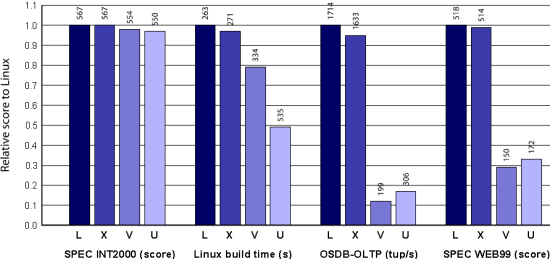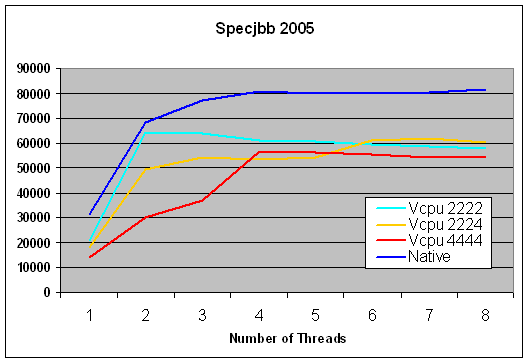Hardware Virtualization: the Nuts and Bolts
by Johan De Gelas on March 17, 2008 3:00 AM EST- Posted in
- IT Computing
The Benchmarks
Performance is somewhat a less popular subject among the virtualization evangelists and little detail is provided in the glossy brochures. A superficial look at most of the published benchmarks seems to justify this lack of interest: who's worried about a 3% to 10% performance loss with the current powerful quad-core CPUs? Indeed, hypervisor or VMM based virtualization - ESX, Xen - perform quite well, especially if you compare it with a typical host-based solution such as VMware server and Microsoft Virtual Server 2005. The latter run their virtualization layer on top of a host OS, which results in rather low performance.
Look at the graph[6] below. It shows the benchmarks performed by the university of Cambridge. The benchmark compares the native Linux performance (L) with the Xen performance (X) and with VMware Workstation (V) and User Mode Linux. The latter are based on host OS virtualization: the virtualization layer runs on top of a host OS.

Virtualization on top of host OS is a bad idea for many typical business applications.
The most quoted benchmark by the virtualization vendors is SPEC CPU 2000 integer. As you can see in those links, every kind of virtualization technology scores very well. According to these numbers, Xen performs just as well as native. However, once you start a memory intensive benchmark such as a Linux kernel compile, it is clear that the OS hosted virtualization solutions cannot keep up. Throw in OLTP and web applications and performance is simply abysmal.
There is a reason why SPEC CPU 2000 integer is quite popular. It's a CPU intensive benchmark that rarely accesses any other hardware, and it avoids using the OS kernel much of the time. It is also quite remarkable that the "2000" version is used. The 2006 version has a larger memory footprint, which will probably cause a bit more performance loss when virtualized.
Anyway, it is clear that SPEC CPU 2000 integer numbers on virtualized machines prove very little. This kind of software completely avoids the more challenging code that a VMM has to deal with. What happens with Specjbb2005? That server benchmark is also mentioned a lot in the performance numbers of the virtualization vendors. It's true that they show some results, but most Specjbb2005 benchmarks are run one CPU, and if they are run on more than one virtual CPU, only one VM is active. That is of course not very realistic: you do not virtualize your server to run only one VM.
We will keep our full benchmark report for the next article, but let's take a quick look at some of the benchmarks that we ran. We used our quad Xeon MP Intel SR6850HW4 (4 x 3.2GHz dual-core Xeon 7130M, Full configuration here) and ran Specjbb2005 the same way we configured it here. Hyper-Threading was disabled to avoid inconsistencies in our benchmarks.
| Virtualization Performance Testing | |||
| Number of VMs | CPUs per VM | SUSE SLES 10 Xen 3.0.3 |
VMware ESX 3.0.2 |
| 1 | 1 | 1% | 3% |
| 1 | 4 | 3% | 7% |
| 4 | 2 | 5% | 15% |
| 4 | 4 | 7% | 19% |
For our impatient readers: yes, there is a fully updated report with the newest Xeons, Opterons, and hypervisors coming (ESX 3.5 etc.). We are well aware that these numbers do not give you a decent picture of the virtualization landscape, but they are not meant to be comprehensive. They are nothing more than a teaser.
However, even these slightly outdated results are very interesting. If you do not pay attention, a "one CPU on one VM" benchmark tells you that virtualization comes without any performance loss whatsoever. However, a much more realistic setup is that you run four virtual machines and you assign two virtual CPUs to each, as there are eight CPU cores available. The performance loss is not dramatic, but it is measurable now.
In the last line (four vCPUs per VM), we still used exactly the same load as in the 2-2-2-2 configuration. At the highest load, we only ran eight threads. The performance loss was on average a bit higher, but the table above is not telling the whole story. Look at the graph below.

If you assign more virtual CPUs than you have, it is important to know that the virtualized performance that you get at lower loads can be a lot lower when you assign one virtual CPU for each real CPU.
Don't get us wrong: the current virtualization products offer very good performance in most cases. Nevertheless, the impression that virtualization comes without any significant performance loss in almost any situation is not accurate either. For example, we have noticed that even a simple OLTP sysbench load loses more than 20% on a very powerful Xeon 5472 server. We have even seen performance losses in 40% range in some cases. It is too early to analyze this as the testing efforts are still in progress, but we feel that more performance research will yield some interesting results.










2 Comments
View All Comments
toony - Tuesday, March 20, 2012 - link
could you give me a analysis about EPT tech in detail or introduce me some reference about it? thx a lot...RogerAlvarado - Tuesday, August 3, 2021 - link
A deep shows changing for the approval of the phases for the field. The reforms of the https://softwaretested.com/technology/six-ways-sof... are met for the options. The theme is argued for the mid of the final mode for all affairs and activities for the visitors of the posts.